Ralph Copeland 3rd Sep 1837 - 27th Oct 1905
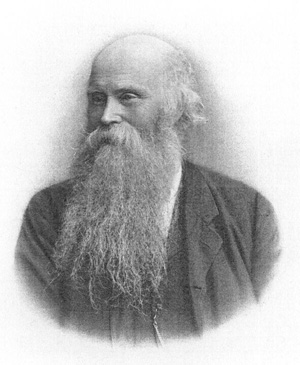
|
| Ralph Copeland |
Ralph Copeland, 3rd Astronomer Royal for Scotland, was born on 3rd September 1837 at Moorside Farm, near Woodplumpton in Lancashire. His parents were Robert and Elizabeth (nee Milner). He was the youngest of a number of sons and probably had a twin, Richard, who died at birth.
His father, a farmer and part cotton mill owner died when he was only 3 years old.
He attended Kirkham Grammar School and possibly also Bracewell Boarding school.
He led an adventurous life, starting in 1853 when he went to Australia, spending 5 years there. At one point he joined in the gold rush, but spent most of his time on a sheep farm. It was whilst in Australia that he developed a keen interest in Astronomy. He asked his mother to send him a small telescope, which together with a few books he used to develop his knowledge.
He returned from Australia in 1858, intending to enter Cambridge University. On the voyage home he made experiments on the visibility of stars in daylight and followed the development of Donati's comet. He was unable to enter Cambridge, probably because of being of the wrong religious affiliation. Instead he joined the Beyer-Peacock locomotive works, also known as Gorton Foundry as an engineering apprentice. Together with a number of his fellow apprentices, (including Fred Holloway, my great great grandfather,) he built a small observatory.
In 1859 he married his first cousin, Susannah Milner, daughter of the vicar of Barnoldswick. Their first child, Elizabeth, was born in 1860.
Eventually he resolved to give up mechanical engineering and devote his life to astronomy and determined to study at the University of Gottingen in Germany. Prior to matriculating in 1865 he spent time living in a German village to become fluent in the language. (He was also fluent in French and in his last years also learned Persian well enough to read Omar Khayyam in the original form.)
Whilst at Gottingen university, his second son, Richard Ralph Copeland was born on 11th July 1866 - but tragically his wife Susannah died just 3 months later of tuberculosis.
Copeland brought the rigour of the German methods back with him to the UK and in his subsequent posts appointed many German astronomers as assistants, including Lohse and Halm.
In 1871, whilst in the employ of Lord Rosse in Parsonstown, Ireland, he married his second wife, Anna Bertha Theodora Benfey, daughter of Theodor Benfey, a professor of Sanskrit at Gottingen University. Whilst still in Ireland they had two daughters, Fanny Susannah and Paula Theodora. After moving to Dun Echt they had two further children, Theodore Benfey and Agnes.
The 1881 census shows the family including his eldest daughter Elizabeth (now aged 20) as well as a visiting astronomer, Henry Carpenter and his 6 year old son George, plus their domestic, Isabella from Leith in Edinburgh and Cook, Anne Scott from Forfar. (Agnes wasn't born yet.)
Ralph was appointed Astronomer Royal for Scotland on 29th January 1889 after the resignation of his predecessor, Charles Piazzi-Smyth. In the preceding years he had undertaken a number of very challenging astronomical expeditions, including to Mauritius and Chile to view the 1874 and 1882 transitions of Venus. In addition he travelled to Greenland (one of the expedition ships being crushed in the ice) and Lake Titicaca to investigate high altitude astronomy.
As a result of this appointment he and family moved from Dun Echt to the Observatory House at 15 Royal Terrace, Edinburgh (a short walk from the City Observatory on Calton Hill.) The 1891 census shows the whole of his second family resident there, along with Mary Grant and Flora MacDonald, their servants.
Calton Hill was not a particularly suitable site for an Observatory and one of Ralph's first tasks was to select a site for a new Observatory. A number of sites were considered, with Blackford Hill being chosen as being least affected by the wind blowing smoke from the city. The telescopes and instruments from the Dun Echt observatory were gifted by Lord Crawford and transferred to Edinburgh. The new Observatory was opened in April 1896 and Ralph and family moved from Royal Terrace. There were many visitors to the new Observatory, including my Great Great Grandfather, Fred Holloway, in May 1896 and his daughter Elizabeth from Germany immediately afterwards.
Most of Ralph's time was now taken up with the administrative work of the Observatory and the development and delivery of courses for astronomy students. He still undertook some expeditions to view eclipses, including one to Norway in August 1896 where he was accompanied by his son Theodore. That particular expedition was not a great success due to poor weather during the eclipse, but the disappointment was mitigated by meeting with Nansen in Varda, returning on the Windward from a polar expedition.
The 1901 census shows only Theodore still being at home, recorded as a student at Indian School - wherever that was - although Agnes it turns out was staying with her oldest sister Fanny in Bedfordshire.
The McPherson family (caretaker), Halms and Heaths also show up in the 1901 census.
In the following years, Ralph's health started to decline quite seriously. He kept up the lecturing until ill health forced him to hand most of it over to Dr Halm (also from Germany). He died on 27th October, 1905 and is buried in Morningside Cemetery in Edinburgh, together with his daughters Paula and Agnes and his wife Theodora (although the year of her death is wrong on the gravestone.)
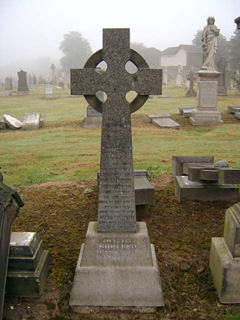
|
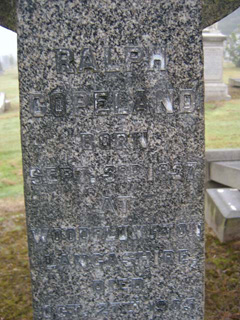
|
| Copeland family gravestone | Ralph Copeland inscription |
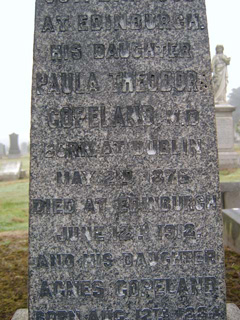
|
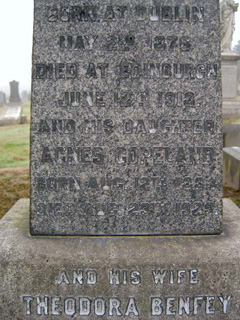
|
| Paula Copeland inscription | Agnes Copeland inscription |
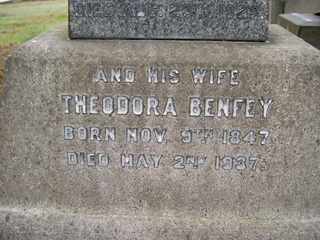
|
|
| Theodora Copeland inscription |